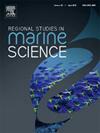Onboard test-based exhaust emission factors for marine diesel engines on anchor handling tug supply vessels
IF 2.1
4区 环境科学与生态学
Q3 ECOLOGY
引用次数: 0
Abstract
In order to accurately assess China’s port air pollution caused by AHTS (Anchor Handling Tug Supply Vessels) ships, 46 diesel engines on 27 AHTS ships were tested for onboard emissions using a large gas analyzer to statistically analyze their fuel-based and power-based emission factors. The results show that fuel-based NOx-emission factors for MEs, SEs and AEs before and after the use of the SCR system are 45.4, 38.24,33.04 g/kg and 6.35, 4.98, 5.82 g/kg, CO-emission factors are 7.95, 6.30, 7.96 g/kg and 6.90, 6.93, 8.32 g/kg, THC-emission factors are 0.49, 0.64, 0.25 g/kg and 0.42, 0.47, 0.22 g/kg, and CO2-emission factors are 3121.62, 3121.34, 3093.12 g/kg and 3088.14,3091.40, 3085.21 g/kg, respectively. Power-based NOx-emission factors for MEs, SEs and AEs before and after the use of the SCR system are 9.71, 8.61, 7.58 g/(kW·h) and 1.37, 1.23, 1.33 g/(kW·h), CO-emission factors are 1.71, 2.08, 1.84 g/(kW·h) and 1.47, 1.53, 1.93 g/(kW·h), THC-emission factors are 0.10, 0.14, 0.05 g/(kW·h) and 0.09, 0.13, 0.06 g/(kW·h), and CO2-emission factors are 671.73, 700.58, 718.46 g/(kW·h) and 664.42, 694.16, 716.92 g/(kW·h), respectively. The power-based emission factor is closely related to the diesel engine load, and the relationship between different exhaust emissions and diesel engine load shows different patterns. In addition, it was found that the NOx emissions of the ship decreased significantly to meet the IMO Tier III requirements after running SCR. The emission factors of CO, HC and CO2 have no obvious change whether SCR systems were operated or not. The AHTS marine engine emission factors obtained in this paper are highly relevant and can provide reliable data for establishing a suitable emission inventory for medium and high speed engineering support vessels.
基于船上测试的船用柴油发动机废气排放系数,适用于锚处理拖船补给船
为了准确评估中国港口 AHTS(锚吊拖轮补给船)造成的空气污染,我们使用大型气体分析仪对 27 艘 AHTS 船舶上的 46 台柴油发动机进行了船上排放测试,统计分析其基于燃料和基于动力的排放因子。结果显示,在使用选择性催化还原系统前后,ME、SE 和 AE 的燃料型氮氧化物排放因子分别为 45.4、38.24、33.04 g/kg 和 6.35、4.98、5.82 g/kg,CO 排放因子分别为 7.95、6.30、7.THC 排放因子分别为 0.49、0.64、0.25 g/kg 和 0.42、0.47、0.22 g/kg,CO2 排放因子分别为 3121.62、3121.34、3093.12 g/kg 和 3088.14、3091.40、3085.21 g/kg。使用选择性催化还原系统前后,ME、SE 和 AE 基于功率的氮氧化物排放因子分别为 9.71、8.61、7.58 g/(kW-h)和 1.37、1.23、1.33 g/(kW-h),CO 排放因子分别为 1.71、2.08、1.84 g/(kW-h)和 1.47、1.53、1.93 g/(kW-h)。THC 排放因子分别为 0.10、0.14、0.05 g/(kW-h)和 0.09、0.13、0.06 g/(kW-h),CO2 排放因子分别为 671.73、700.58、718.46 g/(kW-h)和 664.42、694.16、716.92 g/(kW-h)。基于功率的排放因子与柴油机负荷密切相关,不同废气排放与柴油机负荷的关系呈现出不同的规律。此外,研究还发现,运行选择性催化还原技术后,船舶的氮氧化物排放量明显下降,达到了国际海事组织 Tier III 的要求。一氧化碳、碳氢化合物和二氧化碳的排放因子在是否运行选择性催化还原系统的情况下没有明显变化。本文获得的 AHTS 船用发动机排放因子具有很强的相关性,可为建立合适的中高速工程辅助船排放清单提供可靠数据。
本文章由计算机程序翻译,如有差异,请以英文原文为准。
求助全文
约1分钟内获得全文
求助全文
来源期刊

Regional Studies in Marine Science
Agricultural and Biological Sciences-Ecology, Evolution, Behavior and Systematics
CiteScore
3.90
自引率
4.80%
发文量
336
审稿时长
69 days
期刊介绍:
REGIONAL STUDIES IN MARINE SCIENCE will publish scientifically sound papers on regional aspects of maritime and marine resources in estuaries, coastal zones, continental shelf, the seas and oceans.
 求助内容:
求助内容: 应助结果提醒方式:
应助结果提醒方式:


